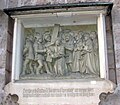Nuremberg Way of the Cross
The Nuremberg Way of the Cross , now also known as the Adam-Kraft-Kreuzweg , begins at the Pilatushaus in Nuremberg's old town, leads through the Tiergärtnertor over Burgschmietstraße to the Johannisfriedhof .
It is an example of an older form of the Way of the Cross with only seven stations created by Adam Kraft in 1506–1508 . At each station the distance from the Pilatushaus is indicated in steps . Today only copies of these works are placed on the Way of the Cross. The original stations are on loan from the city of Nuremberg in the Germanic National Museum in Nuremberg, the crucifixion group in the Heilig-Geist-Spital and the burial in the wooden shoe chapel.
The once colored Stations of the Cross should allow the suffering of Christ to be understood as authentically as possible in one's own home town. They express the passion piety at the end of the Middle Ages. The Stations of the Cross will be cleaned and restored in 2017 on the initiative of Ulrich Großmann , General Director of the Germanisches Nationalmuseum, and in consultation with the owner. The aim is to remove the dark discoloration in order to emphasize the quality more clearly and to harmonize the reliefs. The Way of the Cross should be emphasized as a total work of art.
- Stations on the Adam-Kraft-Kreuzweg
Burgschmietstrasse, in front of the Lenz foundry
literature
- Christian Geyer: On the history of Adam Krafft's stations. In: Repertorium für Kunstwissenschaft 28 (1905), pp. 351–364, 495–511
Web links
- historical-meile.nuernberg.de: Adam-Kraft-Kreuzweg
Coordinates: 49 ° 27 ′ 28 " N , 11 ° 4 ′ 19.4" E








